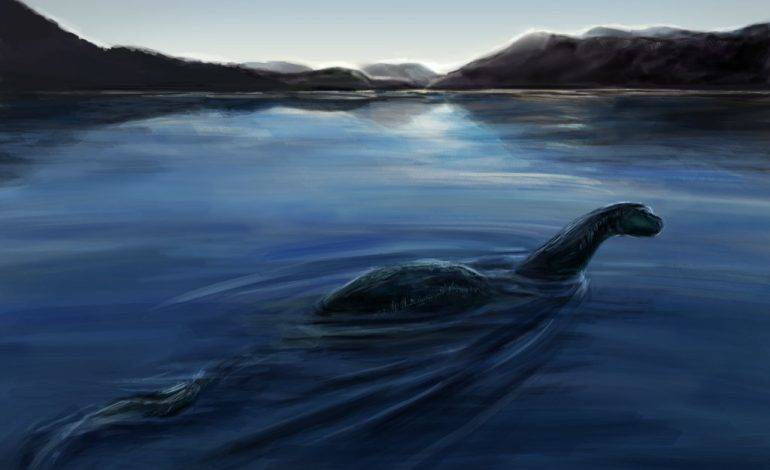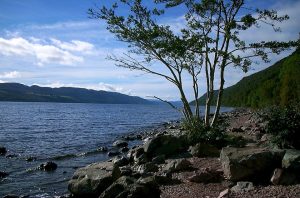
The Mystery of Loch Ness Monster
Everyone has a particular belief about Nessie, she has been a source of mystery and speculation for years, she is what those who study cryptozoology (the scientific study of animals) call a cryptid, cryptozoology is the belief in the existence of animals that has yet to be proven.
Cryptozoologists are committed to their work, their quest is to prove the existence of cryptids, they painstakingly gather information about the creature they are studying. Usually their journey begins through information they receive from sightings by people living in the area of the suspected cryptid. The cryptozoologist begin their journey of gathering information, by first talking to the people who live in the area the cryptid was first sighted.
Photographs, if there are any, are looked at, tales are documented and those that appear to be authentic are filed, it is like gathering pieces of a jigsaw puzzle to get a clear picture of what has been  seen. What they are really looking for is verifiable evidence of their mythical monster. Their ultimate aim being publishable evidence that the source of their interest actually does exist. Hence the unquenchable interest in the Loch Ness Monster, Big Foot, the gigantic shark Megalodon, the African dinosaur Mokele-mbembe. The giant squid Kraken, the monster lizard from Australia and the giant vulture from North America the Thunderbird.
seen. What they are really looking for is verifiable evidence of their mythical monster. Their ultimate aim being publishable evidence that the source of their interest actually does exist. Hence the unquenchable interest in the Loch Ness Monster, Big Foot, the gigantic shark Megalodon, the African dinosaur Mokele-mbembe. The giant squid Kraken, the monster lizard from Australia and the giant vulture from North America the Thunderbird.
For some cryptozoologists theirs is a lifetime quest. There is another cryptid that hails from Scottish fables, the Kelpie is a shape shifting monster of the river, this creature disguised itself as a horse, benignly sidling up to travellers in the area and offering them a ride on its back, only to then drown them in the river. The Loch Ness Monster has remained the most beloved and famous of all the mythical creatures and there is always someone who has a colourful theory regarding Nessie.
The Loch Ness Monster is believed to exist in a large Loch located in the Scottish Highlands, near the city of Inverness, it is connected to a chain of rivers and Lochs that ultimately connect to the Atlantic Ocean. There is still seismic activity in the Loch Ness area, with some earthquakes occurring each century.
Anything on top of the loch is easy to see, yet it is difficult to see under the surface, this is because of the dark brown water that blocks the sunlight from lighting the loch to a depth of no more than four meters. A huge expanse of the loch does not receive any daylight. For a reclusive monster this is the perfect hiding place, making it very difficult for curious and dedicated monster hunters to find their prey. The Loch is approximately 10,000 years old, dating back from the last Ice Age, the depth of the Loch is more than 700ft, it measures 1.6 km in width and is 38 km in length. With the location of the Loch being in an area that is cold, misty and eerie, it is not difficult to imagine a monster moving silently in the depths.
There have been carvings made of a cryptid dating back 15,000 years, these were created by the ancient residents of Scotland, these carvings look like an aquatic creature. There have been tales about the monster living in the Loch for centuries.
The popularity of Nessie hasn’t lessened over the years, no matter what the skeptics of the world say, the ardent believers still pour over photographs and read anything and everything available. You can’t think of Scotland without thinking of the Loch Ness Monster, and you can’t think of the Loch Ness Monster without thinking of Scotland, they are intrinsically linked. Irrespective of sightings by many reputable and credible witnesses, there has been no concrete evidence to confirm the belief that deep in the Loch there lives a monster. This has done nothing to deter the believers and they will continue to seek out that which they believe is eluding them.
From a purely scientific vantage point, scientists agree that if there is a large water monster resembling a long lost dinosaur, it would be necessary for there to be a colony breeding these creatures and a safe haven for them to remain hidden, they would also require an adequate food supply. They believe that if it was necessary for the creature to surface for air, there would have been more frequent sightings.
This monster believed to be living in the depths of Loch Ness, on many occasions, tantalizes those who see it with a fleeting glimpse, before diving again into the Loch. Unlike other giant creatures, there have been no horror stories about Nessie, only scary ones, making her one of the most speculated about ever. The lake itself doesn’t receive much light as the sunlight only penetrates several feet below the water line, beyond this it is very dark, making it difficult for those who are exploring to see very far in front of them. There is the tale of a Saint who courageously saved a swimmer from the jaws of a hungry monster, this was said to have occurred in 565 AD and is one of the earliest references to the Loch Ness Monster.
It is said that a huge underwater cave located deep in the Loch could be the lair of Nessie,and that there may be other discoveries along these lines. Evidence to prove the existence of this most famous mythological creature, has been religiously gathered and scrutinised over the years.
Great Britain first became aware of Nessie in the early twentieth century. In 1933 a man and his wife were driving past the Loch and caught sight of a large creature on the surface of the water, its body was described as similar to that of a whale. After some movement, causing the water to churn, it plunged back into the depths of the Loch and disappeared, leaving enormous amounts of foam frothing on the surface.
A man by the name of Alex Campbell claimed to have seen the monster in the loch on several occasions. He described it as being about thirty feet long with a huge hump, it had a long tapering neck about six feet long and a small head resembling a serpent.
In 1934 Colonel Robert Wilson, submitted a photograph to the local newspaper, in the photograph was a large creature with a long neck and horns, looking very much like the fabled monster. Many years later this photograph was said to be a hoax. There were actually two photographs, called the “Surgeon’s Photo” and some claim one of them is the real photograph of Nessie.
In 1960 someone began an expedition of Loch Ness, he had his black and white camera at the ready, Tim Dinsdale was rewarded with a sighting at the completion of his expedition. He was driving along a road next to the Loch, in the car he had his movie camera, he kept glancing at the Loch hoping to see something before he left.
He stopped his car and with his binoculars was able to define a large object sitting high in the water, he began filming the creature as it veered left and right across the water. As it neared the shore it disappeared under the water, it then reappeared and moved parallel to the shore, creating a distinct wake as it moved through the water. Because of the splash and froth of water either side of its body, Dinsdale concluded that this wonderous sea monster had flippers, he managed to film for four minutes. From this recorded sighting and his utter belief in his finding of the Loch Ness Monster, he later wrote a book.
Also in 1964, a young medical student was out one evening on his motorbike riding next to the Loch, he claimed to have seen a monster moving across the road in front of him and disappearing into the Loch. What he saw had a huge body with flippers, a long tapering neck with a small head, crytozoologists agreed it resembled an aquatic reptilian (plesiosaurus) that had been extinct for over 60 million years.
In 1962 an organisation called the LNPIB (the Loch Ness Phenomena Investigation Bureau) was established, later renamed LNIB (the Loch Ness Investigation Bureau, each year there was a search for the Loch Ness Monster until they disbanded in the early 1970s. When they conducted their expeditions they used sophisticated equipment, including mini-submarines. These one-man submersibles were armed with harpoon guns, to be used for tissue sampling only, disappointingly they never did retrieve a sample to analyse. From this a larger sub was used equipped with sonar, a large object was detected on one occasion although the source of this was never discovered.
A member of Rine’s team was in a small boat on the Loch, he said that the sonar detected a large creature under his boat, he was convinced that there was a monster several feet below his small rowing boat.
Sometime later there was a joint sonar underwater photography expedition, from this, simultaneous sonar and photographic evidence of a large object could be attained. Some intriguing photographs were taken. In the early hours of one morning, two large undefined shapes momentarily appeared on the sonar and pictures were taken, they became known as the “flipper” photos. This took place during the 1972 Robert Rines’s Loch Ness Monster expedition. When these photographs were computer enhanced, a large flipper belonging to a huge creature was discernible. When the second photograph was analysed another large flipper at a different angle was revealed, this enabled Rines to deduce that sonar evidence confirmed there was a monster existing in Loch Ness.
Three years after this magnificent discovery and during another Loch Ness expedition, Rines managed to produce the close up image of Nessie’s head, nothing like this had ever been seen, unfortunately this particular image was actually a large tree stump on the bottom of the loch that was known as “the gargoyle head.”
While sweeping the Loch with sonar equipment, a researcher for the New York Aquarium, picked up the echo of an animate object, he gauged the length to be more than twenty feet, he unfortunately had no images to confirm this sighting, of that which he was sure, inhabited the Loch.
Floating sonar units were placed over an area of the loch in 1983 by experts Alan Kielar, and Rikki Razdan, these were placed on the surface area where there had been the most sightings. Robert Rines, with his undying curiosity, returned to the loch in 2001 doing an extensive sonar search of the loch, he disappointingly discovered nothing.
In the 21st century many scientists have reached the conclusion, that there are a number of creatures, that can from a distance resemble a monster, such as fallen tree branches floating on the loch, especially if photographed as the Sun sets. There have been suggestions of a huge whale or large otters frolicking in the loch that can appear as a monster on film, also otters move in single file making them look like a creature with humps. It is also thought that large seals are at times found in the loch.
One of the most viable conclusions as to what Nessie actually is, suggests that a plesiosaurs somehow escaped extinction and actually managed to breed and feed, while safely hiding in underwater caves. The plesior is a prehistoric creature and scientists do not believe there is any possibility that any could have survived the extinction of the species and managed to thrive in the freezing waters of the loch.
The ultimate believers in the Loch Ness Monster, will not be swayed in their belief that Nessie exists, quite recently paleontologists discovered fossils millions of years old in the waters of Australia. The waters in ancient Australia were freezing and they believe that some of the plesisaur species adapted to the arctic temperatures and evolved enough to enable them to survive in the icy waters of the loch. Plesiosau skeletal fossils have been found by paleontologists, allowing them to piece together a picture of these fascinating creatures and glean something of their history.
The final outcome is that scientists look for that which is not possible and ultimately debunk the myth of Nessie. While the ardent believers will only look at what is possible and their belief in the Loch Ness Monster never wavers, they are always waiting for the day when someone has an up close and personal encounter with the ultimate monster Nessie.
If you believe in fairies, witches, gnomes, goblins, dragons and the like, there is surely a place in your heart that allows you to believe in the possibility of the Loch Ness Monster living happily in the depths of one of the most famous lochs in the world.




